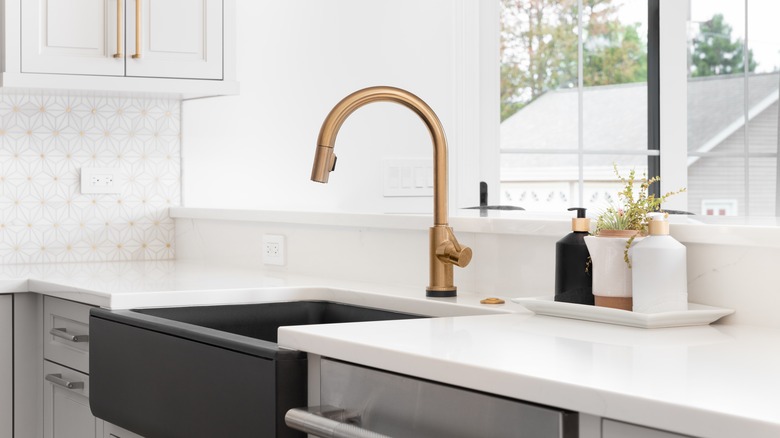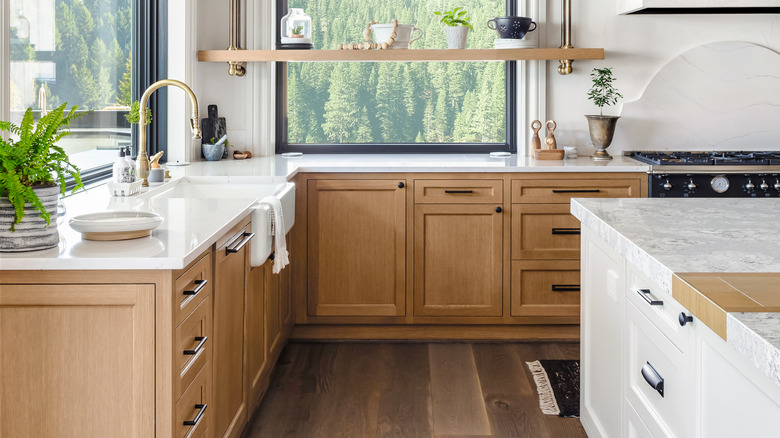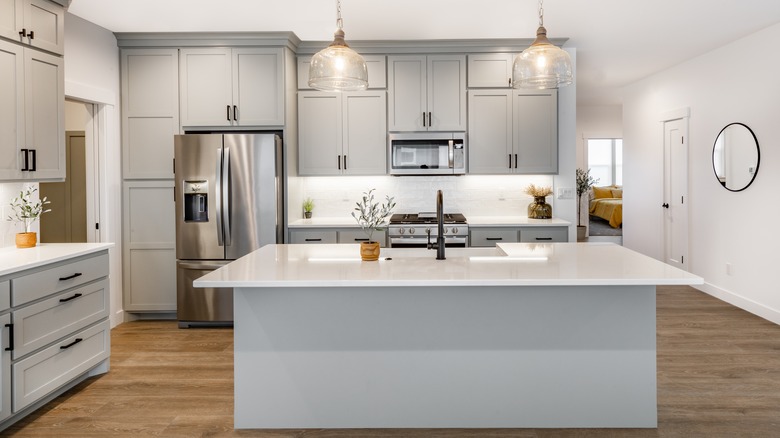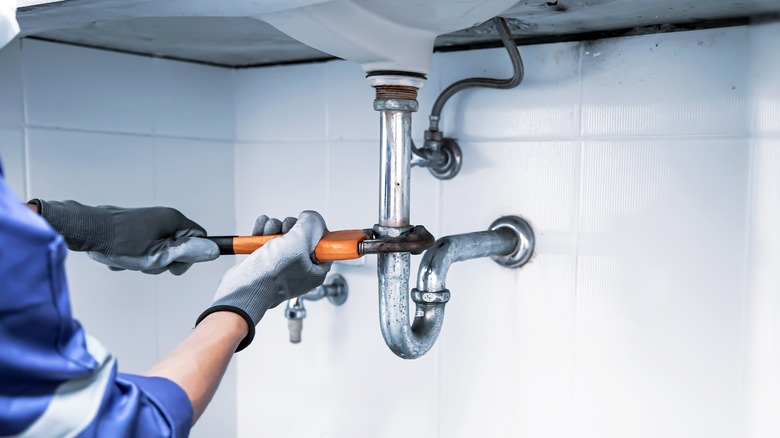The Easiest Way To Install A Farmhouse Sink
Farmhouse sinks are a favorite among homeowners with large families. A farmhouse sink is a perfect addition to any kitchen that sees extensive cooking practices or meal preparation for large groups of people. The farmhouse sink boasts a larger-than-average basin size, making it the perfect option for those who cook with large pots and pans and require ample soaking space during cleanup. A farmhouse sink isn't just for those who cook a lot though. As well as being a functional kitchen feature that makes the cleaning process simpler, farmhouse sinks look fantastic, and they can be a breath of fresh air for homeowners looking to reinvent their kitchen space.
Native Trails notes that farmhouse sinks are named for their historical use in European (and later American) farmhouses. Farming families are often quite large and to facilitate daily activities in the workspace beyond the house, significant meal preparation and batch cooking are often required. While the farmhouse sink remains a staple feature in farming homes, it is also a key element of the modern farmhouse aesthetic and can be found in trickled-out suburban and city properties as well.
Inspect your current kitchen layout
In order to install a new farmhouse sink, the first thing you'll need to do is inspect your existing kitchen layout. As with any new installation project, there is a need to understand what you're currently working with and how you'll make the transformation to this new feature. Preparing the workspace for removal and installation is also crucial before you can even begin to think about the finished product. Fossil Blu reports that you should take note of the countertops in your kitchen as an apron-style cutout will be necessary to utilize this type of sink installation.
Next, you'll need to think about the cabinet space beneath your existing sink. Most sinks have false cabinet drawers directly beneath the sink, but you may have a single cabinet door in this space instead. Removing all of this material will help launch your project. A farmhouse sink sits lower in the cabinet than a traditional sink, so removing these façade pieces will give you access to the workspace required to make this switch.
Consider partnering with a contractor
A farmhouse sink will completely change the aesthetic of your kitchen as a whole. This means that during a sink swap, you may benefit from a change to the countertops as well. New kitchen countertops look fantastic and can go a long way to updating the environment of this space. If you currently have a countertop feature that won't necessarily facilitate the installation of a farmhouse sink, then you might need to change this to complete the renovation. Dori Turner Interiors notes that you'll need to cut a new edge in the counter space. A farmhouse sink extends all the way to the end of the countertop and doesn't require a thin ledge in the front to support the weight of the sink.
Whether you are thinking of replacing the countertops completely or altering your existing countertop to make room for this new installation, it's often a good idea to partner with a contractor rather than tackling this problem yourself, explains Moving. Stone countertops are incredibly heavy and maneuvering one into place is a significant task for any homeowner. But placing and securing this slab is only one part of the job. Contractors are also in a better position to source, prepare, and install these essential features than the typical homeowner.
Brace the area for additional weight
The weight of a farmhouse sink is often much greater than a traditional unit (typically around 150 pounds), according to L'essenziale. As well as the static weight, a farmhouse sink is much deeper, meaning it will support a much larger volume of water and the weight that comes along with it. This makes a farmhouse sink a significant weight addition, considering that the primary use case is in soaking used pots and pans for easier cleaning, resulting in the consistent use of a full sink.
In order to account for this increased weight, you'll need to brace the area beneath the sink, explains Sinkology. This generally requires additional lumber placed throughout the cabinet to ensure it is wrong enough to hold the sink and anything you might place in it, including a full load of water. This is another area in which using the services of a contractor may be beneficial. Homeowners who don't have extensive DIY experience can lean on the expertise of a professional installer. However, anyone who has worked on their own home improvement project before should find this task relatively straightforward.
Place the sink into position
Once the preparation and framing are completed, You are ready to place the sink into position. It's important to use a level and adjust the sink as many times as required before adding any type of sealant to hold the unit in place. Leveling off the sink will create the perfect fit in line with your countertop and cabinets, and it will ensure that the bowl drains properly each time you use it to wash dishes, notes Signature Hardware. An ill-fitted sink not only looks poor but also loses functionality.
Once your sink is positioned properly and you're happy with the placement and level of the installation, you'll need to use silicone around the edges and seams to create a solid, watertight fit and seal to prevent any potential leak damage in the future (via UniBond). Applying sealant should be done after you know the sink is positioned properly and then undertaken with care to create a perfect bond between the sink and its surrounding environment.
Hook up the feature with plumbing requirements
The final step is to reinstall the plumbing hookups. Attaching the drainage outlets and connecting your water line to the faucet will allow you to use your new sink without issue. These types of plumbing tasks are often fairly easy, but a homeowner who doesn't have great confidence in their DIY capabilities might consider hiring a plumber for this last job. A plumber will ensure that the sink is hooked up properly and that you'll have no issues down the road in either filling or draining the unit with regular use, notes Renovation Find.
Your new farmhouse sink is a stunning addition to the kitchen, but it's only useful if it's hooked up correctly. Likewise, you might want to consider changing out the faucet to include more stylistic touches to round out this new aesthetic. Once again, a plumber can help you select and install a new faucet with ease.





